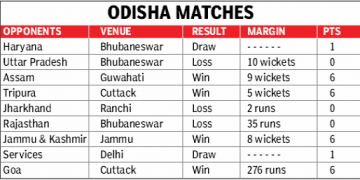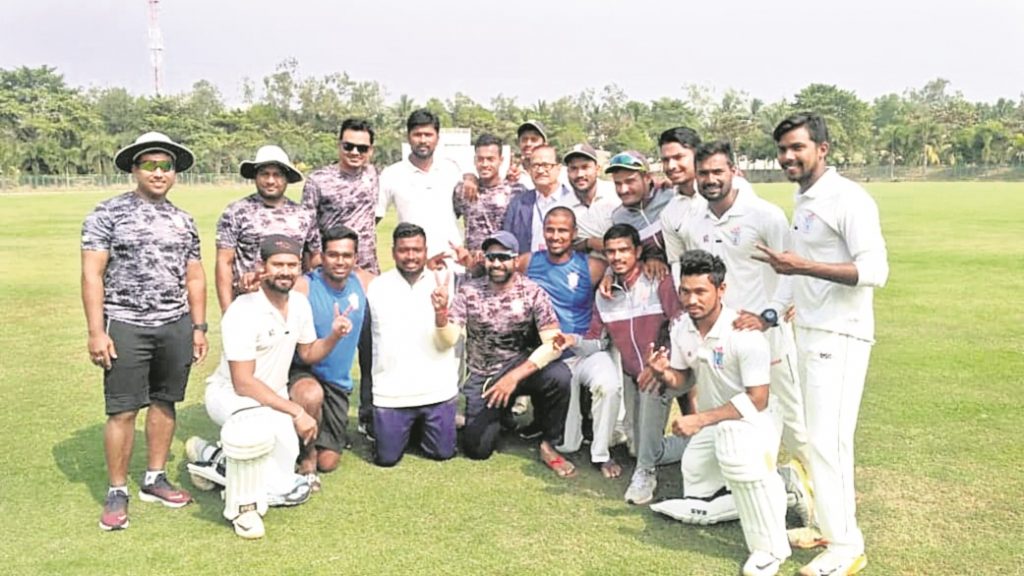The elite domestic competition in Indian cricket – Ranji Trophy 2018-19 – comes closer to its business end as qualified teams gear up for the knock-out stage matches. In the process, some teams got desired and deserved results while some couldn’t make it through to the next round. Odisha are one of those teams this season who showed their improved fighting skill, but couldn’t able to advance.
The season saw some notable changes in participation as well as few changes in format. In April last year, the national cricket board – BCCI – reinstated Bihar for the competition, bringing the total teams to 29. In July, the BCCI increased the total number of teams to 37, with the addition of Arunachal Pradesh, Manipur, Meghalaya, Mizoram, Nagaland, Puducherry, Sikkim and Uttarakhand.
Earlier, the tournament used to have four groups comprising seven teams each. However, after the numbers of participating teams increased, the BCCI changed the knock-out qualification rules as well as group selection.
The regular 28 teams were divided into three groups – called the Elite groups – with Group A and B having nine teams each and Group C with 10 teams. The newly-added teams, nine, were placed in Group D – called the Plate group. To make the competition strong, BCCI allowed the plate group teams to have three professional players each in their squad.
The rule of qualifying, which was earlier set as top two teams from each group advance to quarterfinals, changed. According to the new qualifying format, five top teams, with maximum points, from Group A and B qualified to the knock-outs while top two teams from Group C made it into the quarters. On the other hand, the top team of the plate group grabbed the final last eight spot.
Teams left no stones unturned to prove their mettle. But it was a season of mixed fortunes for Odisha as always. In spite of their all-out efforts and some gutsy performances, they ended up their campaign in agony. Placed in Elite Group C, the team managed to bag 26 points from their nine group matches to finish fourth in the 10-team table.
Odisha had begun their campaign on their home soil – at the KIIT Stadium in Bhubaneswar – against Haryana. In spite of having a century in each innings, their batting was tested. Anurag Sarangi and seasoned Biplab Samantray, who had been given the captaincy ahead of former skipper Govind Poddar, struck wonderful centuries which ensured the team of bagging at least a single point after conceding first innings lead.
Youngsters like Debasish Samantray, Rajesh Mohanty and Debabrata Pradhan – first class debutants – impressed all and sundry. Pappu Roy, who was included after a couple of dominating age group meets, failed to grab his opportunity despite featuring in the Deodhar Trophy and enlisted in the IPL players’ auction list.
Roy failed to impress in the first two matches which led to his ouster from the team. However questions were raised against the selectors’ decision to not give the youngster another chance in the next matches.
In the second match, Odisha were completely outplayed by a visiting Suresh Raina-starrer Uttar Pradesh side. In spite of two notable performances – an 87-run knock by Subhranshu Senapati and a six-wicket haul by veteran Basant Mohanty – there were no positives for the hosts.
The state cricket fraternity also thought of a déjà vu as the state had finished sixth with only six points from six matches last season, and the result against UP had suggested the exact prediction.
However, the team, who were under their new head coach Rashmi Ranjan Parida, left the disappointments behind and notched up their first victory against Assam in Guwahati. Parida, who replaced Shiv Sundar Das, kept his faith on youngsters Rajesh and Debabrata and they grabbed the opportunity with both hands. It was Rajesh who finished with 11 wickets in the match including five in the first innings and six in the second.
Odisha continued their winning run with a victory over Tripura and the pace trio of Basant, Rajesh and especially Suryakant Pradhan, dominated the game sharing 17 out of 20 wickets among them. Then it was the second innings heroics by Subhranshu and Abhishek Raut who forged together 138 runs for the unbeaten sixth wicket to take the team home.
Then came the most unfortunate match against a strong Jharkhand, which shifted like a pendulum throughout. Odisha grabbed a first innings lead and were the dominant side till then, thanks to Basant and Rajesh’s spells and Suryakant’s hard-hitting batting exploits.

Odisha lost to Rajasthan in a low-scoring encounter before beating Jammu & Kashmir. They showed the fighting spirit in a draw against Services before making an end to their campaign with a comprehensive win against Goa.
The match against Services also raised questions over the team selection as Odisha didn’t play a single regular spinner which offered vicious turn in the second half of the match.
In spite of all these results, Odisha had an improved much performnace in the meet than the last season. The scenario could have been different had they managed to pull off wins against Jharkhand and Rajasthan.
However, Odisha found some young talents who are expected to go a long way in future. Subhranshu, in spite of some failures, was excellent throughout the tournament. Debasish had also a wonderful beginning to his first class career with two half centuries and a century in just seven innings.
Among the bowlers, Rajesh and Debabrata impressed one and all while experienced all-rounder Abhishek was consistent with both bat and ball.
As far as seniors are concerned, Basant, Biplab and Suryakant were brilliant. However, it was the form of Govind which disappointed many. And with Debasish performing consistently at Govind’s regular No.3 spot, the former skipper has to prove his mettle again to seal his place again.
As always Odisha proved themselves as an also-ran in the most prestigious domestic tournament of the country. Their performance was a notch above than their last session, but not enough for them to soar. However the only consolation for the side is that they can count a lot of positives.
Counting positives

Odisha Team
